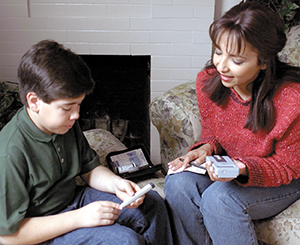Type 1 Diabetes and Your Child: Sick Day Plan
Type 1 Diabetes and Your Child: Sick-Day Plan
When your child is sick, his or her blood sugar (glucose) levels may change. This may make blood glucose harder to manage. You will need to:
Watch your child closely.
Check his or her blood glucose more often.
Check his or her blood or urine for ketones. Ketones are the waste when the body burns fat instead of glucose for energy. The condition is called ketosis.
Adjust your child's insulin dosage. Your child's healthcare provider will tell you what to do.
To be prepared, work with your child's healthcare provider to create a sick-day plan.
Caring for your child
Infections, the flu, and even a cold can cause your child’s blood glucose to rise. And, eating less, nausea, and vomiting may cause his or her blood glucose to fall. When your child is sick you may do the following:
Have a sick-day box ready. Before your child gets sick, make a sick-day box. The box may include: a thermometer, blood and urine ketone testing strips, and medicines your child's provider recommend. The provider may recommend other types of insulin for high glucose levels or glucagon for low glucose levels. Also add a can of soup, crackers, sugar-free juice and regular juice. And keep some frozen juice bars, some with sugar and some without sugar, in the freezer. Check the expiration dates on the contents of the sick-day box once a month.
Encourage your child to eat and drink. This will help regulate your child’s blood glucose and keep him or her from becoming dehydrated.
If your child can’t eat, have him or her sip fruit juices, soft drinks with sugar, or ice cubes made from juice or sugar water. Or try gelatin, frozen juice bars, or low-fat ice cream.
Make sure your child drinks plenty of water. Your child has to stay hydrated.
Test blood glucose often. You may need to check your child's blood glucose every few hours, or even more often.
Don't skip insulin. Always continue giving insulin. Even if your child is not eating, you still need to replace the basal rate of the insulin the body is always producing. Adjust the amount of insulin you give your child according to the sick-day plan. But don't skip insulin, even if your child is vomiting. Skipping insulin could lead to ketoacidosis (see below). Call your child’s provider if you aren’t sure how much insulin you should give your child.
What is ketosis?
The body needs glucose for energy. If the body doesn’t get the glucose it needs, it starts burning fat. But fat is not the best fuel for the body. Ketones can build up in the blood and urine. This is called ketosis. Ketones are a warning sign of ketoacidosis. Check your child's blood or urine for keytones when sick, as directed by your child's healthcare provider, usually every 4 hours. Call your child's provider right away if keytones are present in the blood or urine.
What is ketoacidosis?
When ketone levels are high, it can lead to ketoacidosis. Watch your child for the symptoms of ketoacidosis. They include:
Nausea and vomiting
Stomach cramps
Fast breathing
Fruity-smelling breath
Blurred vision
Hard time paying attention or confusion
Dry or flushed skin
Ketones are positive in the urine and/or blood
Ketoacidosis is a medical emergency. If you think your child has ketoacidosis, call 911 or take your child to the hospital emergency department right away.
Call your child’s healthcare provider
Call your child's healthcare provider if:
You’re not sure how much insulin to give when your child is sick.
Your child’s blood sugar is higher than usual or over 250 mg/dL and doesn’t go down after getting insulin.
Your child's blood sugar level is lower than usual or less than 70 mg/dL.
Your child's blood or urine has ketones.
If you test your child for ketones and think he or she has ketoacidosis, call 911 or take him or her to the hospital emergency department right away.
Resources
For more information about diabetes, visit these websites:
American Diabetes Association www.diabetes.org
Children with Diabetes www.childrenwithdiabetes.com
Juvenile Diabetes Research Foundation International www.jdrf.org
Updated:
February 06, 2018
Sources:
Special Situation in Children with Diabetes Mellitus. UpToDate, Special situations in children and adolescents with type 1 diabetes mellitus. UpToDate
Reviewed By:
Adler, Liora C., MD,Image reviewed by StayWell art team.,Sather, Rita, RN,Turley, Raymond Kent, BSN, MSN, RN
